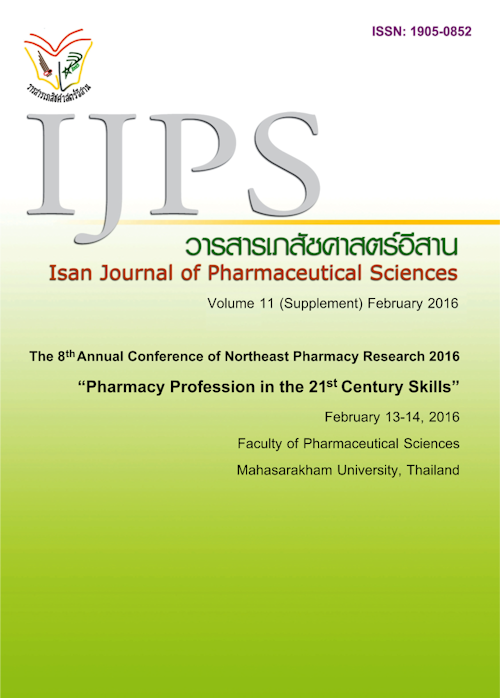Effect of Cholesterol and Oleic Acid on Physicochemical Properties and Stability of Liposomes
Main Article Content
Abstract
Introduction: For a few decades, the applications of liposomes to enhance transdermal drug delivery have evoked considerable interest. It has been known that the presence of cholesterol in liposomes is necessary in order to increase membrane rigidity. However, cholesterol could disrupt local packing orders of the fluid bilayers and decrease the skin penetration. The addition of oleic acid as skin penetration enhancer to liposomes is also known as transfersomes, but their effect on physicochemical properties and stability on the system is not yet to be elucidated. The objective of this study was to investigate the effects of cholesterol and penetration enhancer on the physicochemical properties and the stability of liposome and transfersome formulations. Method: Investigated formulations composed of phosphatidylcholine, ellagic acid (as a model drug) and various cholesterol (as a membrane stabilizer) and oleic acid (as a penetration enhancer) at 0-90 %mol were experimentally formulated and characterized for size, size distribution, zeta potential and entrapment efficiency. Physicochemical stability assessment of the tested formulations were subjected to accelerated condition of heating-cooling cycles at 45 °C for 12 h and 4 °C for 12 h, for 3 cycles. The data obtained were analyzed using conventional experimental and computational method. Results: Results indicated that cholesterol and oleic acid significantly affected the physicochemical properties and the stability of the formulations. The computational method showed the relationship between cholesterol and oleic acid on the vesicle characteristics was more markedly than the conventional experimental method. The computational method suggested the optimal formulation with proper physicochemical properties and stability was found out at cholesterol and oleic acid %mol ratio of 40:40 which was comparable to that of the experimental values. Conclusion: The addition of cholesterol and oleic acid affected physicochemical properties as well as stability of liposomes. The design of experiment used in this study was useful and suggestive for further liposome formulations development.
Article Details
In the case that some parts are used by others The author must Confirm that obtaining permission to use some of the original authors. And must attach evidence That the permission has been included
References
Bahareh S, Mohamed I, Hamid A, Ehsan T, Ali K. Characterization of diclofenac liposomes formulated with palm oil fractions. Trop J Pharm Res. 2014; 13 (2): 185-190
Benson AE. Transdermal drug delivery: penetration enhancement techniques. Curr Drug Deliv. 2005; 2: 23-33
Chermahini SH, Majid FAA, Aziz AA, Yaakob H, Farizhandi AAK. New approaches in topical delivery through using various permeation barrier enhancers. World Appli Sci J. 2012; 31: 2120-2136
Cevc G, Gebauer D, Stieber J, Schätzlein A, Blume G, Ultraflexible vesicles, Transfersomes, have an extremely low pore penetration resistance and transport therapeutic amounts of insulin across the intact mammalian skin.Biochim Biophys Acta. 1998; 1368(2): 201-215.
Duangjit S, Nimcharoenwan T, Chomya N, Locharoenrat N, Ngawhirunpat T. “Development of deformable liposomes for transdermal delivery of extraction from chili pepper” IJPS. 2014a; 10 (Suppl): 112-120.
Duangjit S, Opanasopit P, Rojarata T, Ngawhirunpat T. “Physicochemical stability of meloxicam loaded vesicle formulation: effect of cholesterol”. IJPS. 2014b; 9 (Suppl): 173
Duangjit S, Obata Y, Sano H, Onuki Y, et al. A comparative study of novel ultradeformable liposomes: menthosomes, transfersomes and liposomes for enhancing skin permeation of meloxicam. Biol Pharm Bull. 2014c; 37 (2): 239-247
Haung CM, Chen CH, Pornpattananangkul D, et al. Eradication of drug resistant Staphylococcus aureus by liposomal oleic acids. Biomaterials. 2011; 32: 214-221
Irfan M, Verma S, Ram A. Preparation and characterization of ibuprofen loaded transfersome as a novel carrier for transdermal drug delivery system. AJPCR. 2012; 5(3): 162-165
Jangde R, Singh D. Investigation of drug-excipients compatibility of ellagic Acid for development of formulation containing lipososmes. UKJ PharmChem Biol Sci. 2014; 2:15-18
Junyaprasert V, Singhsa P, Jintapattanakit A. Influence of chemical penetration enhancers on skin permeability of ellagic acid-loaded niosomes. AJPS. 2013; 8: 110–7
Junyaprasert V, Singhsa P, Suksiriworapong J, Chantasart D, Physicochemical properties and skin permeation of Span 60/Tween 60 niosomes of ellagic acid.Int J Pham.2012; 423(2): 303-311
Kanicky JR, Shah DO. Effect of degree, type, and position of unsaturation on the pKa of long-chain fatty acids. J Colloid Interface Sci. 2002; 256: 201–207
Kaur L, Kaur P, Khan M. Liposome as drug carrier – a review. IJRPC. 2013, 3(1): 121-128
Kirby C, Clarke J, Gregoriadis G. Effect of the cholesterol content of small unilamellar liposomes on their stability in vivo and in vitro. Biochem J. 1980; 186: 591-598
Liang X, Mao G, Simon K. Mechanical properties and stability measurement of cholesterol-containing liposome on mica by atomic force microscopy. J Colloid Interface Sci. 2004; 278: 53–62
Naik A, Pechtold LARM, Potts RO, Guy HR. Mechanism of oleic acid-induced skin penetration enhancement in vivo in humans. J Control Release. 1995; 37(3): 299-306
Pathak KS, Roli M, Kumar S, Prakash G, Parthasarthy R. Effect of cholesterol concentration on size of liposome. Int J Pharm Pharm Sci. 2012; 1: 50-53
Ramrit T, Yingngam B, Rungseevijitprapa W, Development of niosome for incorporation of Triphala.IJPS. 2014; 9 (Supplement): 22-26
Srisuk P, Thongnopnua P, Raktanonchai U, Kanokpanont S. Physico-chemical characteristics of methotrexate-entrapped oleic acid-containing deformable liposomes for in vitro transepidermal delivery targeting psoriasis treatment. Int J Pharm. 2012; 427: 426–434
Tseng LP, Liang H, Chung T, Huang Y, Liu D. Liposome incoperated with choresterol for drug release triggered by magnetic field. J Med Biol Eng. 2007; 27(1): 29-34
Verma S, Bhardwaj A, Vij M, Bajpai P, Goutam N, Kumar L. Oleic acid vesicles: a new approach for topical delivery of antifungal agent. Artif Cells Nanomed Biotechnol.2014; 42(2): 95-101
Williams AC, Barry BW, Penetration enhancers.Adv Drug Deliv Rev. 2004; 56(5): 603-618


